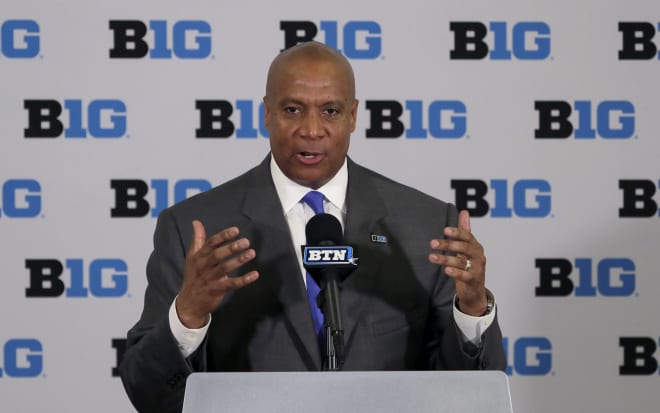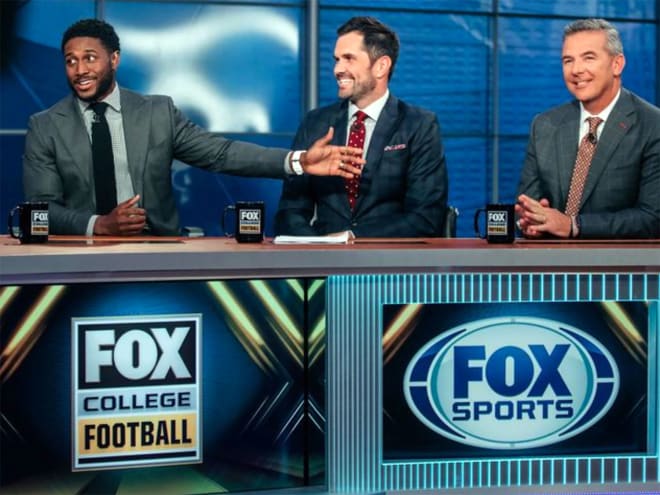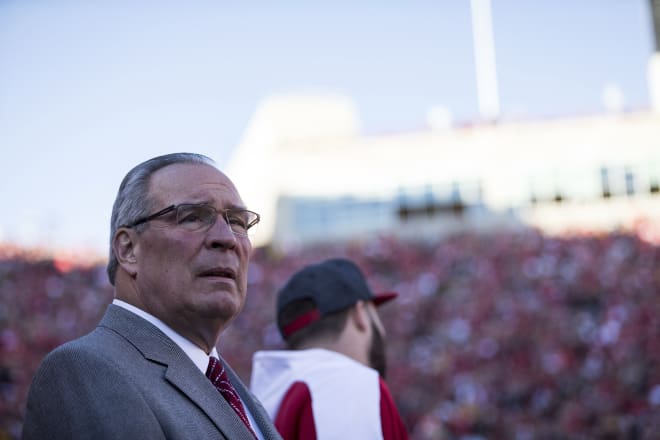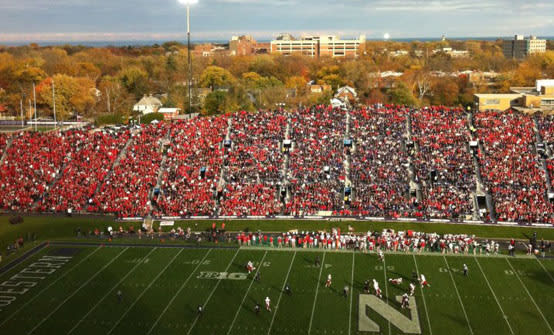Scenarios for preserving $54 million in Big Ten TV money
Science, data, and enormously complicated safety concerns will help determine whether college football will be played this fall. So will television content.
The Big Ten’s media partners -- Fox Sports/BTN and ESPN/ABC -- were at the negotiating table with conference officials and athletic directors in the decision to play a 10-game conference only schedule. And undoubtedly, the networks will help drive what television appearances will look like when the revised schedule l is released perhaps in a matter of days.
Hanging in the balance is a check for about $54.6 million in media rights revenue that would go to each of the 12 schools that are full conference distribution partners. (As the newest members, Rutgers and Maryland would receive smaller checks.)

Several sources said the Big Ten conference’s strategy is to preserve as much television money as possible, assuming games are played during the pandemic. The same goes for other Power Five conferences.
Of those major conferences, only the Big Ten and the Pac-12 have announced their scheduling plans to play only in-conference games. The Pac-12 said details on conference-only schedules will be announced no later than this Friday. A report by the San Jose Mercury News this week said the league is leaning towards a 10-game schedule with things starting on Sept. 19.
The SEC, ACC and Big 12 don’t appear to have the same appetite for conference-only schedules, though those situations are fluid.
Notre Dame must also be part of the equation.The ACC is reportedly considering partnering with the Irish as a league member only for the 2020 season. The Irish and ACC teams would potentially play an 11-game schedule that would include 10 ACC games and one non-conference affair. Notre Dame was originally set to play six ACC opponents. This plan would also take care of the Irish's television partner NBC on the other side, ensuring they get five ACC games for their airwaves.
The Big 12 is considering a full 12-game schedule, while the SEC is talking about playing eight conference games with one out-of-conference game.
Which brings up television content.
A 10-game conference-only schedule for Big Ten schools would create plenty of programming inventory, essentially seven games a week depending on byes. That’s valuable content for network partners who are starving for viewers and advertising revenue. Missing would be some marquee match-ups against non-conference foes. However, three of the Big Ten's highest-profile non-conference games were on the road, and not part of the league's television package - Ohio State at Oregon, Michigan at Washington and Penn State at Virginia Tech.

Bailout partner
Could the Big Ten and its television partners bail each other out? After all, the networks are tied into big-time college sports as much as the conference and its member schools.
One scenario that’s been floated: The Big Ten could opt to cancel the football season if it was guaranteed enough media rights revenue to pay bills. The tradeoff? Extending the network contracts or promising future changes with favorable terms.
Another plan: Expand the college football post-season playoffs to include more schools and more money to distribute.
When commenting about planning for the college football season, Rutgers new president Jonathan Holloway put it this way in a recent interview with NJ Advance Media: “It’s very serious. It relates to the number of games that are on air, potential bowl game revenue, it’s just a whole (slew) of things.”
He said there have been lots of negotiations between Big Ten commissioner Kevin Warren’s office and the league’s television partners regarding potential game-plans this fall, and that the loss of the football season could bring concerns about the status of basketball and other winter sports.

Financial fallout
If the financially lucrative football season is canceled entirely, what would be the revenue impact at Nebraska?
Try $85.3 million in a worst-case scenario, according to an analysis last week by NJ Advance Media. The news organization reviewed how each Big Ten school would be impacted financially if the season were called off.
Advance Media’s number crunch factored in the projected Big Ten media revenue distribution of about $54.6 million with the projected profit each school earns for home games while playing a full season. That operating profit comes from the likes of ticket sales, parking, and concessions, minus game-day expenses.
According to Advance Media, Nebraska generates a football season operating profit of $30.66 million for a full slate of games. Add the check from the conference and the total revenue dip comes to more than $85 million if the season were canceled.
Only Ohio State, Michigan and Penn State would stand to take bigger revenue hits than Nebraska, according to Advance Media’s financial calculus.
Combined, 13 of the 14 Big Ten schools that publicly report athletics budgets -- Northwestern is excluded as a private school -- face potential revenue losses of about $953 million.
Of course, if the revenue distribution is reduced but not entirely eliminated, then the financial hit would not be as severe.
Even in best-case scenarios for a football season, some schools are already bracing for financial losses in athletics.
At Wisconsin, for example, the athletic department said it is anticipating a revenue decline of at least $60 million for the 2020-2021 season because of the Covid-19 pandemic, according to media reports.
If the football season is canceled entirely, the revenue impact would be greater than $100 million, the athletic department said.
It is “highly likely” the athletic department would need to tap reserve funds to cover losses this fiscal year, a spokesman said. Wisconsin has about a $190 million reserve, according to newspaper accounts, most of it held in endowments or targeted for special capital projects.
If the school needs to dip into reserves, it will prioritize rebuilding the fund in the coming years. That’s a signal that the financial impact from the coronavirus will carry on.
In a precautionary move, the athletic department said a planned $77 million renovation of south end zone seating has been pushed back from 2020 to 2021.
Nebraska ‘s athletic department has traditionally been one of the most financially efficient in the conference, if not all major college sports. It is one of the few athletic programs in the country with a revenue surplus, with football, men’s basketball and women’s volleyball showing operating profits. There is no debt on the books, no state government or institutional support and no student fees to pay the bills.
Nebraska, which generated $136.2 million in operating revenue and an operating surplus of $12.1 million in its last fiscal year, has not released its new operating budget for the fiscal year that began July 1. Officials are reviewing data, awaiting schedules, and continuing to work through a 10 percent cost-cutting mandate that included job cuts, salary freezes, and putting the brakes on smaller capital projects such as new artificial turf at Memorial Stadium.
“Lots of drafts but nothing to share,” said John Jentz, the athletic program’s chief financial officer. “Still awaiting more definition on the fall.”

'Super-spreaders'
If football kicks off this fall, will games be played in front of empty or partly empty stadiums?
And who will get into the stadiums?
Most Big Ten schools, including Nebraska, have acknowledged they’re looking at options on socially distanced seating, and ticket distribution..
For example, Nebraska is considering how to safely seat fans if Memorial Stadium is allowed to be at 33 percent, 50 percent, or full capacity. At 50 percent, about 45,000 fans could be in the stadium. (Texas said it is figuring on limiting seating by 50 percent.)
Here’s what other conference schools have said:
*Rutgers announced it will impose a limit of 500 fans for home games, complying with the standards set by the New Jersey governor on public area gatherings.
*Illinois will limit capacity to 20 percent, or about 10,000 to 12,000 fans. No tailgating will be allowed on university grounds, and face coverings will be required.
*Michigan, which is facing a projected $26 million athletic department deficit, said seating at the Big House will be reduced. However, a final decision on capacity will come at a later date.
The university said it will not sell tickets to the general public, only to students and season-ticket holders.
*Michigan State athletic director Bill Beekman is hoping to see 20 percent to 30 percent capacity at Spartan Stadium, which seats abolut 75,000, according to the Detroit Free Press. But university president Samuel Stanley is a little less optimistic, and he said the actual number might even be lower than that.
*Ohio State is considering several seating scenarios, including one to limit seating at Ohio Stadium to 22,000 fans per home game.
*Iowa tickets sales at the end of June. Only fans who had renewed their season ticket orders and paid per-seat contributions by June 30 will be included in any potential Kinnick Stadium seating plan.
By halting ticket orders, Iowa hopes to take more time to figure out how seating will look at the 69,000-plus seat stadium. It was scheduled to open the season Sept 5 against Northern Iowa, but that game has been wiped off the schedule by the conference’s decision to eliminate non-conference games.
*The Minnesota Golden Gophers still hope football attendance reaches 100 percent capacity at TCF Bank Stadium this fall, but with the COVID-19 pandemic, “the reality of that is probably dwindling by the day as we get closer,” associate athletic director Mike Wierzbicki told the Minneapolis Star Tribune recently.
Wierzbicki said the department is planning for various contingencies, including filling the stadium at 75 percent, 50 percent and 25 percent of capacity.

*Northwestern has said its Nov. 7th game against Wisconsin will be moved from Wrigley Field to Ryan Field on the Wildcat’s campus. The school cited concern about the potential for a large gathering at Wrigley.
*Purdue’s Ross-Ade Stadium seats about 57,000. The Purdue athletic department said an initial plan calls for a capacity of 15,000, or about 25 percent of the stadium’s total seating. That could be adjusted up or down as Covid-19 conditions evolve.
“We are not looking at going beyond one fourth of 57,000 in our stadium, Purdue President Mitch Daniels said.
*Wisconsin’s athletic department is working with campus officials to determine how many -- if any -- fans would be allowed to watch the Badgers home games in person, according to athletic director Barry Alvarez
*Penn State plans to significantly lower the number of fans who will be in the 106,000-plus Beaver Stadium for home games, according to a notice sent to former football lettermen.
To date, the university’s top administrators have not made a firm announcement on reducing capacity in the fall. In June, university president Eric Barron did say that games played at Beaver Stadium would have “the potential to create a super-spreader event,”
He also said he had heard so far of “no university that intends to have a full stadium going into the fall.”
Steve Rosen writes about the business of sports for HuskerOnline. Questions, comments, story ideas? Reach Steve at srosen@huskeronline.com.